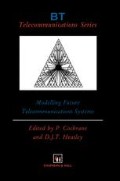Abstract
Management science has for over thirty years been concerned with mathematical and computer models at the macro, meso and micro levels of detail to support corporate decision-making in planning, management and control, which reflects the classical three-level military hierarchical planning concepts of strategic long-run, tactical medium-run and operational short-run [1] (see Table 6.1). As planning moves down the corporate hierarchy it becomes increasingly detailed and involves shorter timescales and many more, but smaller, uncertainties. The mathematical modelling involved at successively lower levels reflects these differences — paralleling the macro, meso and micro-scale mathematical models of classical physics (e.g. see Woods [2]) — increasing in complexity at each level (see Table 6.2). In a stationary corporate environment, operational planning models — involving mainly management and control functions — can become extremely complex. In a highly dynamic uncertain environment, useful mathematical and computer models tend to become simpler, as it is the strategic and tactical decisions involving rarer major uncertainties which are critical for survival.
Access this chapter
Tax calculation will be finalised at checkout
Purchases are for personal use only
Preview
Unable to display preview. Download preview PDF.
References
Anthony R N: ‘Planning and control systems: a framework for analysis’, Harvard U Press (1965).
Woods L C: ‘The thermodynamics of fluid systems’, Oxford U Press (1975).
Dirickx Y M I and Jennergren L P: ‘Systems analysis by multilevel methods: with applications to economics and management’, Wiley, New York (1979).
Dempster M A H: ‘A stochastic approach to hierarchical planning and scheduling’, in Dempster M A H, Lenstra J K and Rinnooy Kan A G H (Eds): ‘Deterministic and stochastic scheduling’, Reidel, Dordrecht, pp 271–296 (1982).
Dempster M A H, Fisher M L, Hansen L, Lageweg B, Lenstra J K and Rinnooy Kan A G H: ‘Analytical evaluation of hierarchical planning systems’, Operations Res, 29, pp 707–717 (1981).
Sharma R L: ‘Network topology optimization: the art and science of network design’, Van Nostrand Rhienhold, New York (1990).
Bertsekas D P and Gallager R G: ‘Data networks’, Prentice-Hall, Englewood Cliffs, NJ (1989).
Hui J Y: ‘Switching and traffic theory for integrated broadband networks’, Kluwer, Norwell, Mass (1990).
Chen H and Mandelbaum A: ‘Stochastic discrete flow networks: diffusion approximations and bottlenecks’, Annals of Probability, 19, pp 1463–1519 (1991).
Kelly F P: ‘Reversibility and stochastic networks’, Chapter 8, Wiley, New York (1979).
Kelly F P: ‘Loss networks’, Ann Appl Probability, 1, pp 319–378 (1991).
Kleinrock L: ‘Queueing systems’, Vols 1 and 2, Wiley, New York (1975).
Molloy M K: ‘Fundamentals of performance modelling’, Macmillan, New York (1989).
Borwein J M and Dempster M A H: ‘The order complementarity problem’, Maths of OR, 14, pp 534–554 (1989).
Harrison J M: ‘Brownian motion and stochastic flow systems’, Wiley, New York (1985).
Chen H and Mandelbaum A: ‘Leontief systems, RBVs and RBMs’, in Davis M H A and Elliott R J (Eds): ‘Applied stochastic analysis’, Gordon and Breach, New York, pp 1–43 (1991).
Davis M H A: ‘Piecewise-deterministic Markov processes: a general class of non-diffusion stochastic models’, J Royal Stat Soc, B46, pp 353–388 (1984).
Dempster M A H: ‘Optimal control of piecewise deterministic processes’, in Davis M H A and Elliott R J (Eds): ‘Applied stochastic analysis’, Gordon and Breach, New York, pp 303–325 (1991).
Sen S, Doverspike R D and Cosares S: ‘Network planning with random demand’, Tech Report, Systems and Industrial Engineering Dept, University of Arizona (December 1992).
Dempster M A H and Gassmann H I: ‘Computational comparison of algorithms for dynamic stochastic programming’, Submitted to ORSA J on Computing.
Higle J L and Sen S: ‘Stochastic decomposition: an algorithm for two-stage linear programs with recourse’, Maths of OR, 16, pp 650–669 (1991).
Dantzig G B and Infanger G: ‘Large scale stochastic linear programs: importance sampling and Benders’ decomposition’, Tech Report SOL91–94, Dept of Operations Research, Standford University [to appear in Ann of OR] (1991).
Medova E A: ‘ATM admission control and routeing’, Internal BT technical report (December 1993).
Hui J Y, Gursoy M B, Moayeri N and Yates R D: ‘A layered broadband switching architecture with physical or virtual path configurations’, IEEE J on Selected Areas in Communications, 9, pp 1416–1426 (1991).
Labourdette J-F P and Acampora A S: ‘Logically rearrangeable multihop lightwave networks’, IEEE Trans Comms, 39, pp 1223–1230 (1991).
Medova E A: ‘Network flow algorithms for routeing in networks with wavelength division multiplexing’, Proc 11th UK Teletraffic Symp, Cambridge (1994).
Newton N J: ‘Variance reduction for simulated diffusions’, Tech Report, Dept of Electronic Systems Engineering, University of Essex (1992).
Editor information
Editors and Affiliations
Rights and permissions
Copyright information
© 1996 Springer Science+Business Media Dordrecht
About this chapter
Cite this chapter
Dempster, M.A.H. (1996). Hierarchical Modelling. In: Cochrane, P., Heatley, D.J.T. (eds) Modelling Future Telecommunications Systems. BT Telecommunications Series, vol 7. Springer, Boston, MA. https://doi.org/10.1007/978-1-4615-2049-8_6
Download citation
DOI: https://doi.org/10.1007/978-1-4615-2049-8_6
Publisher Name: Springer, Boston, MA
Print ISBN: 978-1-4613-5850-3
Online ISBN: 978-1-4615-2049-8
eBook Packages: Springer Book Archive

